A 365-Day Project
"We Are All Mozart"
A project to create
new works and change
the perception of the
music of our time.

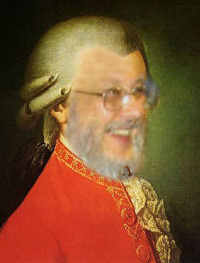
 October 4, 2006
October 4, 2006 
It may not have been clear yesterday what actually matters about musical notation, and why it is any sort of an issue for disagreement, much less passion. It is important because notation is so much more tightly bound to meaning than is the on-page presentation of words. Save for the rare poet such as E. E. Cummings, the specific placement on the page of words does not significantly affect how they are read. Certainly book designers take time to increase legibility or create a visual style, but the clarity or ambiguity of the words are not changed by design. Spelling matters -- you know something about me if I write "draught" instead of "draft", perhaps something more if you read "colour" rather than "color" -- but how I spell the notes between E and G has implications to musical meaning rather than an assist to decoding the author's background.
There is a distinction in purpose and practice between music notation and words. We do not speak or read or listen to words in counterpoint; though our listening is informed by the ambience, most of the time we can obtain only one meaning-stream. (The vacant look at a restaurant table is a giveaway that the person across from you is no longer hearing your words, but rather eavesdropping on a juicier conversation.) Music offers its meaning through the single stream of melody, the multiple stream of counterpoint, and -- most significantly -- the collective meaning of several sounds at the same time. Have three people say respectively "love of my life", "lice in the bed" and "mind of your cat" at the same time and there is only a clatter of sound from which we are lucky to pluck any meaning at all. But have those three people pick up instruments and play C-G-C, F-D-E, and A-B-G and you hear both the three-note melodies and a chord progression.
This isn't a lesson in psychoacoustics, just a tiny catalog of distinctions. If we open up another catalog, we can look at the different ways music is approached by composers, performers and directors, and how those approaches overlap.
The composer is creating a document that charts a set of musical ideas. It isn't necessary to dive into the murky swamp of the creative process to grasp the basic features of such a document. It contains a sufficient but not complete map of a composition and the instructions needed to render it into sound. Where assumptions can be made through other documentation -- jazz swing rhythms as recorded, Baroque ornamentation as described or extrapolated, vibrato as handed down -- instructions are largely left out of the notation.
Assumptions are for the composer's present day. As those who reconstruct Baroque (and earlier) performance practice can attest, the information provided by the composer can be slim. Techniques have vanished into history, instruments have gone obsolete, mnemonic devices have changed. A notation as simple as a small note preceding a larger one: what is that? Fifty years ago, most living-room piano teachers would think of it as a grace note, a flick of sound before the main note. But scholarship has trickled down to the living room, and that small note is a flick of sound for the Nineteenth century, but a downbeat dissonance to be resolved in early Eighteenth century, or the part of a florid phrase a few decades later. It is a notational ambiguity informed by historical knowledge.
As historical repertoire built up like silt behind a dam, composers realized that they would have to anticipate the forgetfulness of the future, and provide that future with increasing informational detail. No longer would a pattern of notes be good enough, but their manner of articulation would need to be specified, their speed communicated exactly, and their techniques indicated. The library of musical symbols grew as more were added to aid in the disambiguation. How should the violinist place the bow on the instrument? In what direction should it be pushed or pulled? With what manner of movement? How loud? Normal or muted? With vibrato? Near the fingerboard or the bridge? Lifting the bow off the string at the end? Perhaps it is a harmonic instead of the fundamental note, and if so, will it be natural to the string or artificially created between bow and finger? Or maybe it is to be plucked instead? Then how to pluck -- with the flesh of the finger, the side, or the fingernail? Does the string hit the fingerboard or sound freely? Vibrato or not? How about the effect of using the back of the bow (not new -- Rossini did it in Il Signor Bruschino in 1813) or paper in the strings (nope, also not new -- Biber did that in Battalia in 1673).
And that's just writing for a string player. The composer uses techniques for brass and woodwinds and especially percussion, whose array of instruments continues to burgeon as more culturally local instruments are brought into nonpop ensembles. By the middle of the last century, when avant-garde experimentation and total serialism were both abloom, the information to be conveyed in a musical score ran from the overgeneralized to the overspecified. The two examples below (from Aurora Cagealis for twelve performers and Rose Quartz Crystal Radio for just two) show that contrast.
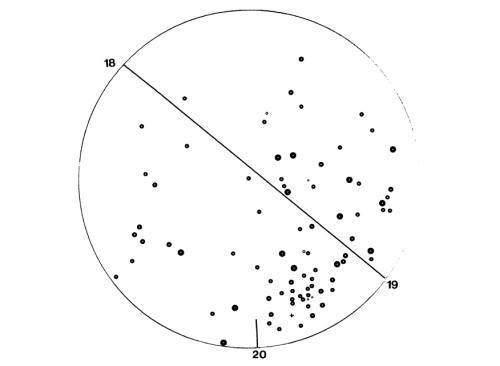
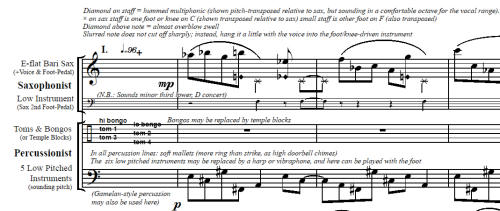
The composer's role is to choose a set of symbols and arrange them in a way that will best represent the music -- whether it's hands-off or -on, as with the above examples. Sometimes it's a code for performance, but with many composers it also includes an important visual sense, that the music's impact is best conveyed when it looks like it feels, appears like it sounds.
And it doesn't stop there. The composer's manuscript is transformed by publication -- or today's equivalent of publication, as an increasing number of manuscripts are computer-engraved. But what happens during that process? Below are three examples from the same piece:
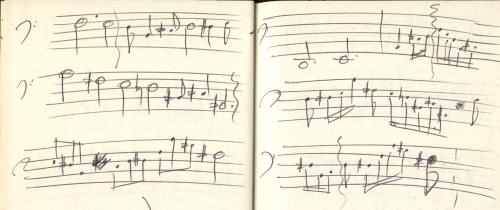
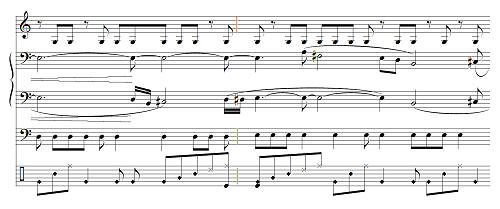

The first is from my notebook. Having neither computer nor manuscript paper with me, I wrote Into the Morning Rain as separate parts into a blank journal; the image is one of the bass clarinet parts. It has a certain flavor of motion in the manuscript, but being my own engraver, I could reflect that in the score (the second image; not the same excerpt as the notebook pages). You'll see no barlines in the two bass clarinet parts in notebook or score (the wiggly and dashed lines in the notebook are guide markings when I was transcribing the piece to computer). There are vertical lines in the violin, cello and percussion parts, but these are phrase 'module' breaks rather than measures.
But look what happens in the bass clarinet performer's part (the third image); it looks different from the same clip shown in the score. The performers couldn't keep their places without barlines, and requested parts written in a simple 4/4. Through it completely misrepresented the melodic flow of the music, I had to agree to their request to get a performance to work at all. The performance ended up being very good, but the change of the notation -- not a change of the overall note values or pitches -- had them playing as if there were syncopations written ino the score. The tendency to accentuate non-existent syncopations was a consequence of adding barlines, a tendency the performers needed to suppress to achieve an idiomatic performance.
The point is that the character of notation and the composer's chosen details matter far more than the mere sequence of pitches and durations on the page.
The director assesses the document for its content, its structure and as many ideas as can be discerned from the evidence left by the composer. There are multiple problems. The composer may have failed in notating all the content, the editor and publisher may have failed in the faithful rendition of the included content, and the director may not have time or ability to discern enough elements to create musical coherency. The director should be -- but often is not -- conversant with the style of the composition. With the newest of nonpop, nonpop without precedent, that failure can be understood because style has become so personal that consultation with the composer is all but mandatory.
Directors of music within the past fifty years are beset by all the notational variations from the avant-garde through minimalism to postmodern classicism. If they are traditional directors, they will often chafe at notational practice that has moved away from Nineteeth century practices, particularly if traditional and non-traditional methods are in transition and hence simultaneous. A few days ago I mentioned the transposition nightmare of the Berlioz Symphonie Funèbre et Triomphale when brought to modern instruments. Contemporary practice differs on how to avoid this nightmare, and beginning with Schoenberg and Berg, many composers wrote scores that sound as they are written.
Explaining this requires a diversion. Musical instruments are mechanical devices, one advantage of them being their malleability. Take an oboe, make it bigger, and there's an English horn. Clarinets come in a half-dozen sizes. So do tubas and trumpets. There are big flutes and little ones. To exploit all these shapes and sizes, the composer took on the role of performer assistant. Instead of the performer having to remember a separate fingering for every note on each different size of instrument, a note was just a note. Play a C on one size instrument and it sounded like a C. Play it on another, and it sounded like a B-flat. On another, an E-flat. On another, an F. Or a G. This mechanical trickery made tremendous orchestral color possible without straining the players and encouraging mistakes. Yes, this is all a simplification, but the practical advantages for effective performance of these transposing instruments are many.
But what should the director see in the big score? The sounding note or the player's note? If the player's note appears in the score, the director has to transpose it mentally back to the correct pitch to 'hear' it correctly, but knows exactly what the player is seeing. Correcting performance errors is facilitated. If the sounding note appears in the score, the director can 'hear' the whole score effortlessly, but cannot be certain precisely what the player is seeing -- a G-sharp or an A-flat? The rendering of the conductor's score is a point of tension between composer and director, and it is only one area in which notational conflict might arise. (Disclosure: all my scores are done at sounding pitch.)
The director must resolve all the notational issues and conceive of the score as music before ascending the podium for that first rehearsal.
The reading performer is almost too general a term, fracturing into ensemble performers and solo performers, and within them mechanics-driven instrumentalists (those who use notation as instructions for placement of fingers and methods of presenting the sound), music-driven instrumentalists (those who use notation as a guide to the sound, particularly with string players who have no keys to press), and singers (who must bring abstract notation into their bodies and articulate the results).
With respect to performers, most of the notational problems have already been discussed both above and yesterday. Ensemble and solo performers do differ psychologically, as composers learn with some measure of experiential pain; leaders and team players are no less distinct in the musical world than they are in business or politics, with passive-aggressive behavior easily triggered by unfamiliar notation. But these are more psychological issues than notational ones, and grist for another day's mill. Instrumentalists of all stripes resent ambiguity, appreciate clarity, and expect efficiency. As with the bass clarinet example from Into the Morning Rain, compromise for efficiency can be the only available route to performance. Instrumental notation is also idiomatic, and composers who notate outside conventions (whether accidentally or deliberately) risk artistic dismissal -- i.e., a miserable performance.
Finally, there is the page -- where this discussion began many days ago.
Music is a real-time activity with symbolic representation. The process that begins with the on-page symbols and ends as sound in the air proceeds through recognition, short-term memory (musicians read ahead), biological and mechanical action, outside influence (the director), and feedback (placement, expression, tuning, and interaction with other performers), all driven by a constantly changing stream of symbols. This delicate process should not be perturbed by illegible printing, poor placement of symbols, cramped pages, or problematic page turns. Even after the composer/publisher respects those simple rules of the road, however, the performance highway gets bumpy with new and unfamiliar music.
The increase in professional engraving tools has not brought with it an increasing awareness of legibility, placement, visibility, and convenience, a circumstance made worse by the difficulty of using engraving software and the poor defaults shipped with notation programs. And unfortunately, many techniques of page clarity and balance learned through hand-copying of music have fallen away in just a decade -- before software has caught up with the past. With the wide availability of notation software, a similar process is underway to that which obviated such disparate tools as long division, spelling, typesetting, and stick-shifting. Some were trivial, others offered long-term benefits. In this period of transition of both musical notation and notation programs, however, a plethora of awkward scores continues to be made.
Postscript: Two days ago, I mentioned metadata. Here are two interesting papers, both from the same source at Sony France. The first (PDF) has a cogent description of the kind of metadata used in the imaginary HarpoX, but the second (PDF) has some fairly bogus descriptions, clearly written from an engineer's rather than a musician's standpoint; check out in particular lines 153-154. What will the future think?
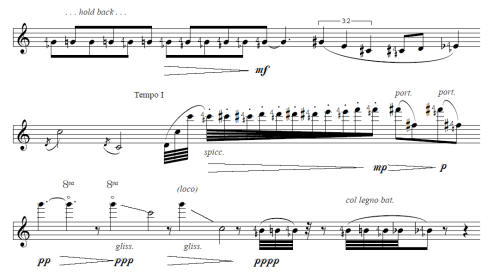
An excerpt from Thièle, created in Finale version 2.2 in 1993. Hand-inking scores helped me make this look pretty good for such a stiff, old version of the program.